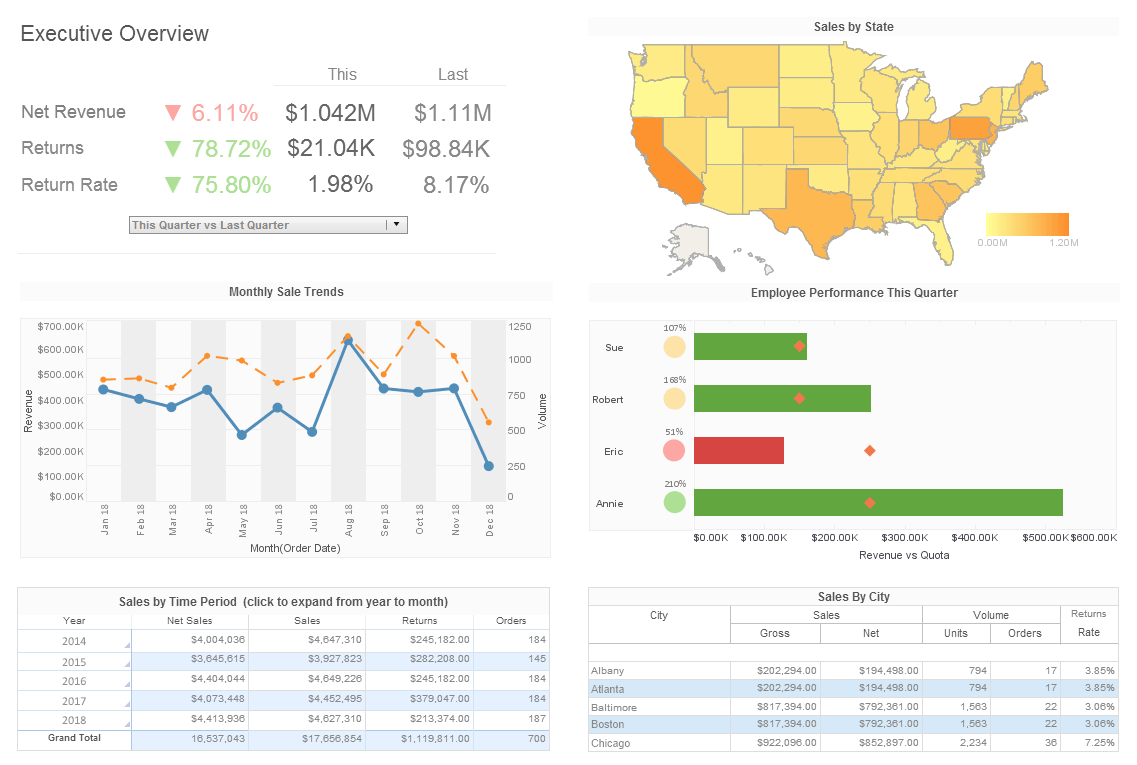The Linchpin of a Good Performance Management System
This is the continuation of the transcript of an in-person customer seminar hosted by InetSoft on the topic of "Ingredients for a Performance Management System to Succeed." The speaker is Christopher Wren, Principal Consultant at TFI Consulting.
Okay. Strategic objectives are the linchpin of a good performance management system because there is a lot of potential and a lot of energy associated with them. For one thing, they are tied to our strategy and our desired results. They are the building blocks of that shared vision. By having people accountable for objectives, we are building accountability for results in the organization.
So we put owners next to the objectives. By tying initiatives to objectives, we ask ourselves what are the critical products that we have to do to be successful to continuously improve? By tying performance measures to the objective, we ask the simple question, how well are we doing against our strategy result that we want, the overall result.
And finally, an important step that we have added after running into some difficulty early on is what we call objective commentary. What’s going to happen, folks, if you have workshops who are building the balanced scorecard? I guarantee you six months after the consultants are gone, and you’re left to your own devices.
| #1 Ranking: Read how InetSoft was rated #1 for user adoption in G2's user survey-based index | Read More |
Document the Objectives
You meet again for the next time. What’s the first thing that’s going to happen when you and I see this objective without any commentary? I am going to interpret it one way, and you’re going to interpret it, no, that’s not the way I remember the discussion. All right. So make sure that you take the time to have a court reporter or somebody in the room when you build these systems who can synthesize what they’re hearing. What that does is give you the ability to have some documentation around the objectives.
Alignment comes from strategy. Aligning, the work in an organization comes from a corporate scorecard. At tier one is vision. Decompose the strategy into objectives. At tier two are business and support units. Those objectives that are corporate ones can be linked to the business unit objectives.
Finally, when I get down to the desktop at tier three, I can take my critical success factors or my objectives, if you will, and link them to the business unit, that’s the way we build alignment in an organization. That’s through strategy.
Be Careful Cascading Measures
Folks, be careful here because this is the misstep a lot of organizations make when they cascade their measures. What happens when you cascade measures off of corporate objectives at tier one? Do you still have strategic intent, or have you lost the bubble?
I guarantee you’ve lost it because now what happens? Now, I want to talk about the stuff I know best. How do I measure something? Or, what measures do we currently have? That’s even worse. All right. So the longer you can continue the dialogue on what are we trying to accomplish, the more strategy focused you’re going to become.
It really is that simple. And it’s also that hard. It is darn hard to do this in a disciplined way because people don’t want you to take them there. They want to talk about their favorite projects, they want to talk about the sandboxes that they love to play in, they want to talk about performance measures.
Performance measures come at the end, folks. There are means to an end. They are not the end. So be careful about that trap. Finally, you get the align slide, and the alignment goes from the corporate tier down to tier three. Here is another view of it.
If you can take your objectives at tier one and align performance measures and some strategic initiatives, through those objectives you’re directly tying measurement and the initiatives to the DNA of strategies. So you got a direct link to strategy.
 |
Learn about the top 10 features of embedded business intelligence. |
Make Measures Department Specific
At tier two, what I’m going to do is take my department’s ability to assist customers as an example. My measure will be different. My initiatives will be different because I’ve dropped down to the department level. At tier three, and now I am at my desktop. How am I going to improve my individual skills which support my department’s ability to perform better which directly support improved ease of customer access to our products or services? So it’s all aligned.
When we talk about communications, what we’re talking about is a ladder of effectiveness, if you will. All of this is one way stuff, right? Recognize that younger audiences have very different responses to electronic media than most old folks do. All right. It’s a different world with the younger folks.
But what really works is two-way communications. This is where we want to get to. We want to get to one on one or a small group dialogue. You know, this stuff isn’t very interesting. There’s PowerPoint somewhere in here. If I would stop and you know we could dialogue, you know we could move it up a little bit, right?
| Previous: Visualizing Success Is an Important Part | Next: Performance Management System Workshops |



